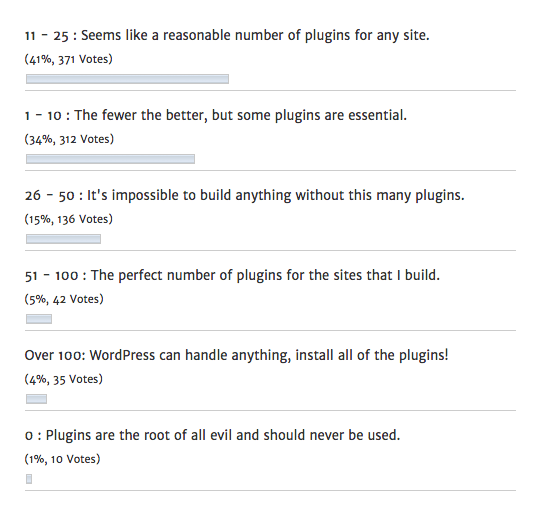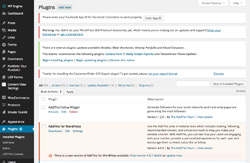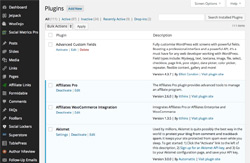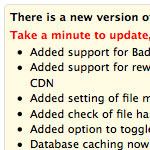Poll: How Many WordPress Plugins is Too Many?

A frequent question in the WordPress community is “how many plugins is too many?” We’ve heard responses that vary from “zero” to “no limit, man”.
So for this DigWP Poll, I figured it would be interesting to see what people think about it. To give you a better idea, I’ve posted some screenshots of sites running LOTS of plugins. So check ’em out and then cast your vote!
Examples of sites running 50+ plugins
Before voting, take a few moments to check out the following screenshots. They showcase the Admin Area of a couple of actual sites running over 50 plugins. Not gonna say anything more than that, just check ’em out and then vote for whichever response makes the most sense to you.
And here are some further screenshots for your consideration:
Update:
It has been mentioned several times in the comments that “too many” depends on the quality and resource requirements of each plugin. For example, many lightweight, well-coded plugins may be fine, but even just one badly coded resource hog is too many. So I’m updating the post to specify that we’re talking about “typical” WordPress plugins for this poll. That is, in general.
Poll Results
How many plugins before it’s “too many”?

Total Voters: 906
Thanks for voting!
35 responses
-
Really depends on the plugins… i.e. 50 very light weight ones would be preferable to 5 very badly coded resource-intensive ones…
-
I am crying at the thought of debugging plugin conflicts in those examples.
-
The problem with this poll is that ONE plugin is too many if it’s badly coded and wrecks the site’s performance, but you can run lots of plugins if they are lightweight. A simple site might have fewer than 10 plugins, but a more complex site is going to have a minimum of 20, just from the extensions added to support e-commerce, events, forms, etc. It’s possible for a site with 50 plugins to run just fine, but I always try not to use more plugins than I really need.
-
All it takes is one bad apple… On the other hand you could have 50+ and be fine if you know what you’re doing.
-
They need to delete every single inactive plugin.
-
I’ve always wondered, is there any difference between an inactive plugin and one that is no longer installed?
-
-
One of the best things a WP dev can do is to start making a list of plugins that are tried and true, and pick from that list. All too often we fall into trouble by quickly filling a need from the WP plugin repository, only to find out it was poorly coded.
-
Agreed. The repository needs a total overhaul – a stricter review process to get in, tighter controls on staying in and some sort of true rating or badge system (even old ratings become irrelevant). It’s one of WordPress’ weakness and just fuels the reputation of not being a professional solution.
-
-
Of course, a big offender is multisite. It’s not uncommon to see a busy multisite situation with many, many plugins.
I know of one where there are at least 125+ plugins running on it. Maintenance and troubleshooting is a bear. Multisite, by its nature tends to run toward more plugins than less as sometime different features are desired for the different subsites. Of course, managing the mixed activations alone can be a headache by itself.
-
I agree with above comments. It is all about how well plugin is coded.
One bad plugin can mess things up. It is always good to use only regularly updated and supported free or paid plugins.
Too many plugins is pain in the ass for debugging when things go down the road.
I personally try to make it simple and use only must have plugins and try to keep it below 20.
-
Hi, i prefer no-plugin way,how many plugins do you use on digwp? I must use few of them, like woocommerce, mailchimps, wpml
Maybe someone can create blacklist/worening for really bad coded plugins? So we can avoid them Cheers :) -
With my old theme (I just change theme few days ago) I have 40+ plugins installed and activated. Site still run smoothly and fast. Peoeple were surprise to know that I use that much plugin as they avoid to have less. Now I run about 30+ and it still fast. Nothing break. I think it is depends on what kind of plugin and before you installed it, Make a research!
-
This has been my experience as well, no issues running 40+ plugins that are popular and supported.
I’m curious, can you list what plugins you commonly use and or post a screenshot of your Admin area?
-
-
Newbie here, but I observed that every time I install a new plugin, gtmetrix shows that process request from my blog increases, process request eats server resources right, I am on a shared hosting and that is not good. Keeping plugins under 20, all essentials only, seems good.
-
Install whatever plugins you want as long as the plugins are up to date and come from official sources (Official Repo and/or Envato, etc). However, most plugins use either or both of PHP and MySQL.
My recommendation is to use PHP and MySQL resources on your local server as little as possible to minimize the slow loading of your site. You can achieve that by using plugins which use third-party resources, such as Disqus. Or if you either have the time or the ability to modify the code, you can have someone or yourself to modify the source code of the plugins to use the resources from other servers of your own, such as use Cron on another server to process the articles on your site and tweet it.
-
As for MySQL, I recommend to use SQLite or other type of database (or MySQL from another server) to maintain the size of the core WP database along with the site loading speed.
-
-
I usually try to keep the number of plugins around 10-15. It really depends on the website and theme that I use for that particular project. If the theme that I use comes with a slideshow and has a very complex structure, I prefer to have no more than 10 plugins.
If WooCommerce or other resource heavy plugin is used on the website, I always advice to build the shop and the website on different database.
-
Too many plugins is pain for debugging when things go down the road.
I personally try to make it simple and use only must have plugins and try to keep it below 10.
Editor’s note: comment edited to remove profanity.
-
I try to ask myself two questions every time I consider a plugin:
Can it easily be fixed by custom theme code? Does it actually benefit the client by making their job faster and easier?
Something like a security plugin, of course I’ll use it. But if the problem I’m trying to solve is something that can be handled better by sticking it in a widget or custom theme snippet, I’ll probably pass on installing it, especially if my client is not going to edit it any time soon.
That said, my final loadout for any given WordPress site tends to fall between 12 and 16 plugins. Of that, some of those will be left deactivated, only to be used once in a great while – like “Better Delete Revisions,” “Regenerate Thumbnails” or “Better Search Replace.”















